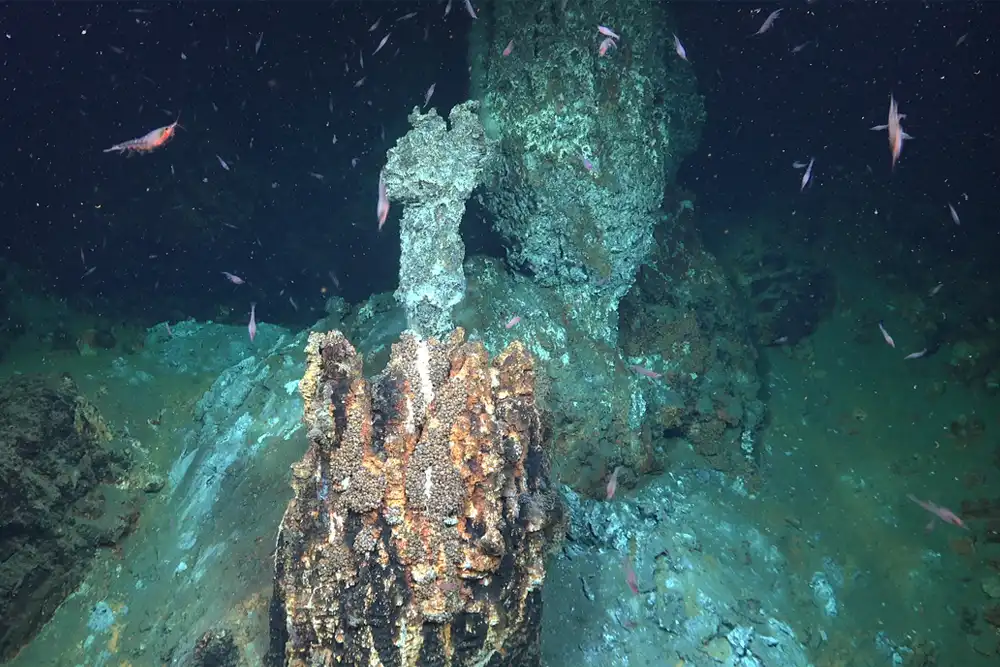
By DIVE Staff
Previously unknown coral gardens and a system of hydrothermal vents have been discovered by an international team of scientists during an Ocean Census Flagship expedition to the remote South Sandwich Islands.
Many species previously unknown to science have also been discovered, including corals, sponges, snails, sea urchins, benthic ctenophores (deep-sea comb jellies), and sea stars
The 35-day deep sea expedition was conducted from Schmidt Ocean Institute’s research vessel Falkor (too), the same expedition that earlier captured the first confirmed footage of a juvenile colossal squid.
The South Sandwich Islands are a remote island chain, part of the British Overseas Territory that also includes South Georgia. located approximately 1,700km (1,100 miles) northeast of the Antarctic Peninsula.
Related articles

The islands are some of the most remote and inaccessible locations on the planet, home to a group of active volcanoes and one of the coldest and most isolated deep-sea trenches in the oceans.
It took Falkor (too) eight days to make her way from Punta Arenas in Chile, during which time the scientists had to navigate around icebergs, and were subjected to a subsea earthquake, tropical storm force winds with hurricane-level gusts, and eight-metre (26 ft) waves.
The Schmidt Ocean Institute’s researchers were joined by a scientific team from GoSouth, a collaborative initiative between the University of Plymouth (UK), GEOMAR (Germany), and the British Antarctic Survey (UK).
Led by Co-Chief Scientist Dr Jenny Gales, the GoSouth team discovered two ‘pockmarks’ in a map of an underwater caldera, the bowl-shaped depression left by an erupting volcano, which can be an indicator of hydrothermal activity.

Schmidt Ocean Institute’s remotely operated vehicle, SuBastian, was deployed to map the sites and confirm the presence of four hydrothermal vents at a depth of 700 metres (2,300 ft), the shallowest to have been discovered near the South Sandwich Islands, and the first in the area to have been explored by an ROV.
Each vent was covered with organisms such as sea snails and barnacles that are dependent on chemosynthesis for survival.
Unlike photosynthesis, the process by which plants convert sunlight into chemical energy, life around hydrothermal vents is fuelled by bacteria that have evolved to convert inorganic chemicals, such as hydrogen sulphide spilling from the vents, into organic matter.
Thriving coral gardens and large sponges were found in close proximity to the vents.


‘Discovering these hydrothermal vents was a magical moment, as they have never been seen here before,’ said Gales, an associate professor in Ocean Exploration at the University of Plymouth (UK).
‘It’s an incredible discovery that provides valuable insights into the area’s tectonic activity. Making such a discovery is rare. It highlights the importance of ocean exploration and seafloor mapping.’
The exact number of new species will be announced later this year following an Ocean Census workshop, where taxonomic experts will formally assess and catalogue the findings in the initiative’s rapidly growing database of new discoveries.
‘This expedition has given us a glimpse into one of the most remote and biologically rich parts of our ocean,’ said said Dr Michelle Taylor, head of science and expedition principal investigator at the Ocean Census. ‘This is exactly why the Ocean Census exists — to accelerate our understanding of ocean life before it’s too late.
‘The 35 days at sea were an exciting rollercoaster of scientific discovery,’ added Taylor; ‘the implications of which will be felt for many years to come as discoveries filter into management action.’


